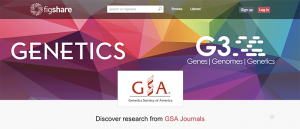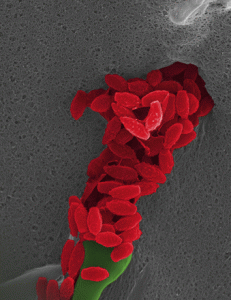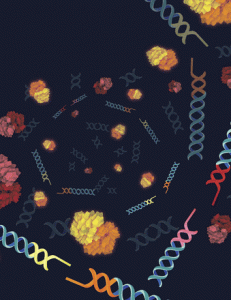Enter your address to receive notifications about new posts to your email.
Articles tagged G3 Journal
(174 results)
-
The Genetics Society of America and Figshare partner to promote data underlying publications
The GSA Journals are excited to announce that we have partnered with Figshare to archive supplemental material and data from papers published in GENETICS and G3: Genes|Genomes|Genetics. When you publish a paper in GENETICS or G3, you help to catalyze scientific advances by sharing experimental reagents, results, and interpretations. For these articles to have the…
-
Three GENETICS articles from 2017 recognized with Editors’ Choice Awards
Congratulations to the winners of the Editors’ Choice Awards for outstanding articles published in GENETICS in 2017! The journal’s Editorial Board considered a diverse range of articles, finding many papers worthy of recognition. After much deliberation, they settled on one exceptional article for each of the three award categories: molecular genetics, quantitative genetics, and population and evolutionary genetics.…
-
Get outbred: Genetic diversity in laboratory gerbils
Biologists rely on animal models to answer important questions that can’t be addressed with cells in a dish. Often, these animals are deliberately inbred; a less diverse population of animals means that data obtained from experiments with these animals will be less noisy and easier to interpret, so fewer animals are needed for meaningful results.…
-
How baker’s yeast turns from friend to foe
Beer, doughnuts, and genetics textbooks have one thing in common: they were all made possible by collaborations between humans and yeast. Our fungal ally Saccharomyces cerevisiae resides not only in breweries, bakeries, and laboratories, but also sometimes in our own bodies—where, on rare occasions, it betrays us. S. cerevisiae is increasingly being reported as an…
-
Hyper-conserved sperm proteins can still evolve rapidly
The fastest-evolving genes in eukaryotes commonly encode reproductive proteins—and the rate at which genes for male reproductive proteins change, in particular, often vastly outstrips the rate of change across the genome as a whole. A recent paper in G3: Genes|Genomes|Genetics describes an unusual exception: the amino acid sequences of the most abundant sperm proteins in…
-
New in G3: Genome Reports galore, genomic prediction in cauliflower and trout, and use of a sibling subtraction method
Check out the February issue of G3! Table of Contents Genome Reports Whole Genome Sequencing of Hulunbuir Short-Tailed Sheep for Identifying Candidate Genes Related to the Short-Tail Phenotype Dafu Zhi, Lai Da, Moning Liu, Chen Cheng, Yukun Zhang, Xin Wang, Xiunan Li, Zhipeng Tian, Yanyan Yang, Tingyi He, Xin Long, Wei Wei, Guifang Cao G3: Genes, Genomes, Genetics…
-
A fly that thrives on a deadly diet
When a noni fruit ripens, it stinks like old cheese—or even vomit. Familiar to many in the form of expensive juices sold as health supplements, this pungent fruit is engaged in a slow-motion arms race with would-be insect pests. Fruit flies are unable to feast on noni—scientific name Morinda citrifolia—because the fruit is dosed with…
-
New in G3: mutant screens, Japanese quail evolution, and mating design in MAGIC sorghum
Check out the January issue of G3! Table of Contents Genome Report Reference Assembly and Annotation of the Pyrenophora teres f. teres Isolate 0-1 Nathan A. Wyatt, Jonathan K. Richards, Robert S. Brueggeman, Timothy L. Friesen G3: Genes, Genomes, Genetics January 2018 8: 1-8; DOI: https://doi.org/10.1534/g3.117.300196 Mutant Screen Reports Mapping Second Chromosome Mutations to Defined Genomic Regions in…
-
Circulomes vary based on cell type
In the 1980s, scientists first noticed circles of DNA interspersed among the normally linear chromosomes of eukaryotic nuclei. Little is known about these molecules, which are called extrachromosomal circular DNA (eccDNA). Variation in eccDNA appears to be biologically significant; development of an organism often comes with increased numbers of eccDNA, for example, and certain types…
-
Benign yeast turn into filamentous pathogens in different ways
The yeast Candida albicans lives on and even inside many of us. Most of the time, its silent presence goes unnoticed, but this fungus can turn on its host, causing infections ranging in severity from annoying to life-threatening. For the yeast to become pathogenic, some of the C. albicans must transform from small, round cells…
-
New in G3: software and data resources, overdominance in flower color, and histone mutant libraries
Check out the December issue of G3! Table of Contents Software and Data Resources ARSDA: A New Approach for Storing, Transmitting and Analyzing Transcriptomic Data Xuhua Xia G3: Genes, Genomes, Genetics December 2017 7: 3839-3848; DOI: https://doi.org/10.1534/g3.117.300271 rSalvador: An R Package for the Fluctuation Experiment Qi Zheng G3: Genes, Genomes, Genetics December 2017 7: 3849-3856; DOI: https://doi.org/10.1534/g3.117.300120 Investigations…








![Image by Michael Hermann (Own work) [CC BY-SA 3.0], via Wikimedia Commons.](https://s43361.pcdn.co/wp-content/uploads/2018/01/Webp.net-resizeimage-19-300x225.jpg)



